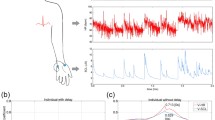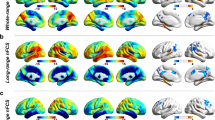Abstract
In the present report assumed relationships between hypercortisolism, depression and cortico- cortical cross-talk in Cushing’s syndrome were investigated. Electroencephalographic (EEG) recordings and depression ratings from three patients diagnosed with mild, moderate and severe hypercortisolism were obtained. Reductions in cortico-cortical cross-talk as quantified by EEG coherence together with increases in depression were observed in the moderate and severe as compared to the mild hypercorticolism state. These findings provide preliminary evidence for the hypothesis that loss of cortico-cortical cross-talk might be linked to hypercortisolism and the severity of depressive symptoms.
Similar content being viewed by others
References
Boscaro M, Barzon L, Fallo F, Sonino N. Cushing’s syndrome. Lancet 2001, 357: 783–91.
Gold PW, Drevets WC, Charney DS. New insights into the role of cortisol and the glucocorticoid receptor in severe depression. Biol Psychiatry 2002, 52: 381–5.
Nieman LK, Chrousos GP, Kellner C, et al. Successful treatment of Cushing’s syndrome with the glucocorticoid antagonist RU 486. J Clin Endocrinol Metab 1985, 61: 536–40.
Schutter DJLG, Van Honk J, Koppeschaar HPF, Kahn RS. Cortisol and reduced interhemispheric coupling between the left prefrontal and the right parietal cortex. J. Neuropsychiatry Clin Neurosci 2002, 14: 89–90.
Nunez PL, Srinivasan R, Westdorp AF, et al. EEG coherency I: statistics, reference electrode, volume conduction, Laplacians, cortical imaging, and interpretation at multiple levels. Electroencephalogr Clin Neurophysiol 1997, 103: 499–515.
Leuchter AF, Cook IA, Uijtdehaage SH, et al. Brain structure and function and the outcomes of treatment for depression. J Clin Psychiatry 1998, 58: 22–31.
Schutter DJLG, Peper JS, Koppeschaar HPF, Kahn RS, Van Houk J. Administration of testosterone increases functional connectivity in a cortico-cortical depression circuit. J Neuropsychiatry Clin Neurosci, in press.
Roemer RA, Shagass C, Dubin W, Jaffe R, Katz R. Relationship between pretreatment electroencephalographic measures and subsequent response to electroconvulsive therapy: A preliminary study. Neuropsychobiology 1990, 24: 121–4.
Van der Lely AJ, Foeken K, Van der Mast RC, Lamberts SWJ. Rapid reversal of acute psychosis in the Cushing syndrome with the cortisol-receptor antagonist mifepristone (RU 486). Ann Int Med 1991, 114: 143–4.
Murphy BEP, Filipini D, Ghadirian AM. Possible use of glucocorticoid antagonists in the treatment of major depression: preliminary results using RU486. J Psychiatry Neurosci 1993, 18: 209–13.
Belanoff JK, Rothschild AJ, Cassidy F, et al. An open label trial of C-1073 (Mifepristone) for psychotic major depression. Biol Psychiatry 2002, 52: 386–92.
De Kloet ER, Vreugdenhil E, Oitzl MS, Joëals M. Brain corticosteroid receptor balance in health and disease. Endoc Rev 1998, 19: 269–301.
Mosmose KJ, Kjellberg RN, Kliman B. High incidence of cortical atrophy of the cerebral and cerebellar hemispheres in Cushing’s syndrome. Radiology 1971, 99: 341–8.
Simmons NE, Do HM, Lipper MH, Laws Jr ER. Cerebral atrophy in Cushing’s syndrome. Surg Neurol 2000, 53: 72–6.
Cook IA, Leuchter AF, Morgan ML, et al. Cognitive and physiologic correlates of subclinical structural brain syndrome in elderly healthy control subjects. Arch Neurol 2002, 59: 1612–20.
Bourdeau I, Bard C, Noel B, et al. Loss of brain volume in endogenous Cushing’s syndrome and its reversibility after correction of hypercortisolism. J Clin Endocrinol Metab 2002, 87: 1949–54.
Schutter DJLG, d’Alfonso AA, Van Honk J. Counterintuitive antidepressant properties of slow rTMS over the left frontal cortex: A possible mechanism. J Neuropsychiatry Clin Neurosci 2003, 15: 243–4.
George MS, Nahas Z, Kozel FA, et al. Mechanisms and state of the art of transcranial magnetic stimulation. J ECT 2002, 18: 170–81.
Rosenberg PB, Mehndiratta RB, Mehndiratta YP, Wamer A, Rosse RB, Balish M. Repetitive transcranial magnetic stimulation treatments of comorbid posttraumatic stress disorder and major depression. J Neuropsychiatry Clin Neurosci 2002, 14: 270–6.
Jing H, Takigawa M. Observation of EEG coherence after repetitive transcranial magnetic stimulation. Clin Neurophysiol 2001, 111: 1620–31.
Van Honk J, Schutter DJLG, Putman P, De Haan EHF, d’Alfonso AAL. Reductions in phenomenological, physiological and attentional indices of depressive mood after 2 Hz rTMS over the right parietal cortex in healthy human subjects. Psychiatry Res 2003, 120: 95–101.
Nicolson N, Storms C, Ponds R, Sulon J. Salivary cortisol levels and stress reactivity in human aging. J Gerontol A Biol Sci Med Sci 1997, 52: 68–75.
Duffy FH, McAnulty GB, Albert MS. Effect of age upon interhemispheric EEG coherence in normal adults. Neurobiol Aging 1996, 17: 587–99.
Lupien S, Lecours AR, Lussier I, Schwartz G, Nair NPV, Meaney MJ. Basal cortisol levels and cognitive deficits in human aging. J Neurosci 1994, 14: 2893–903.
Lupien S, Lecours AR, Schwartz G, et al. Longitudinal study of basal cortisol levels in healthy elderly subjects: evidence for subgroups. Neurobiol Aging 1996, 17: 95–105.
Sharma M, Palacios-Bois J, Schwartz G, et al. Circadian rhythms of melatonin and cortisol in aging. Biol Psychiatry 1989, 25: 305–19.
Dorn LD, Burgess ES, Friedman TC, Dubbert B, Gold PW, Chrousos GP. The longitudinal course of psychopathology in Cushing’s syndrome after correction of hypercortisolism. J Clin Endocrinol Metab 1997, 82: 912–9.
Author information
Authors and Affiliations
Corresponding author
Additional information
An erratum to this article is available at http://dx.doi.org/10.1007/BF03347509.
Rights and permissions
About this article
Cite this article
Schutter, D.J.L.G., van Honk, J., de Haan, E.H.F. et al. Cortisol, depression and reduced cortico-cortical cross-talk in Cushing’s syndrome. J Endocrinol Invest 27, 683–686 (2004). https://doi.org/10.1007/BF03347504
Accepted:
Published:
Issue Date:
DOI: https://doi.org/10.1007/BF03347504




